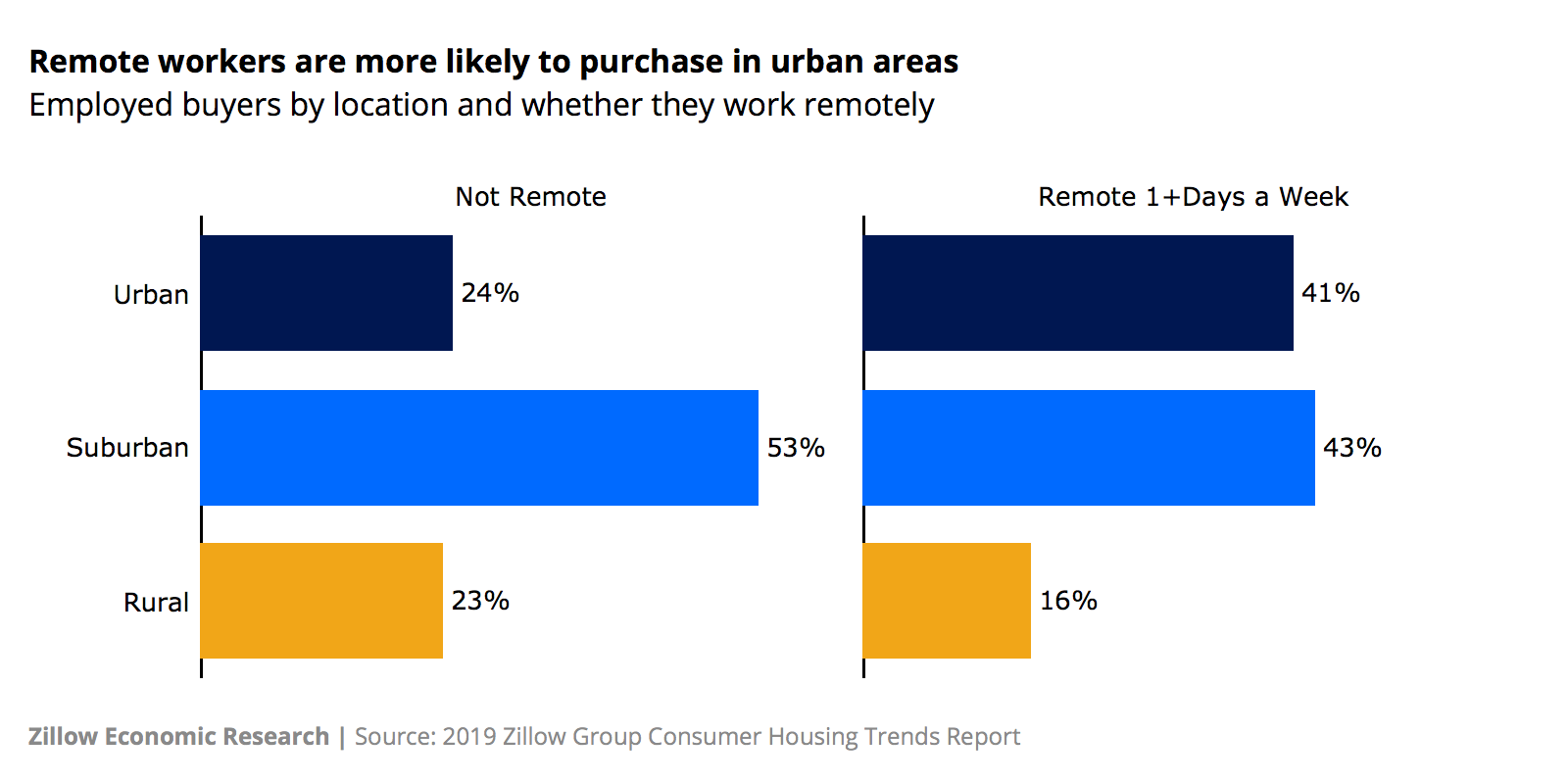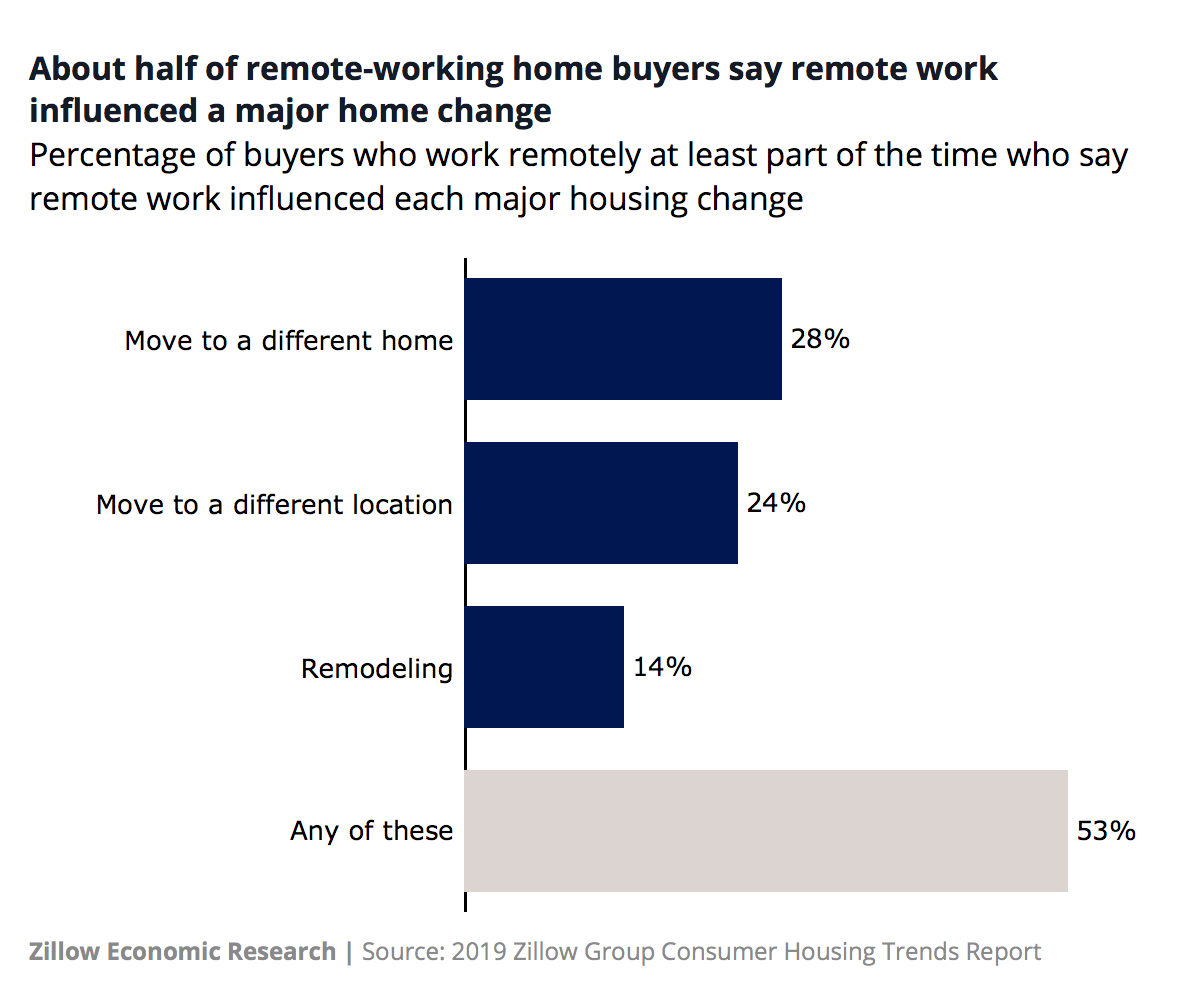People spend an overwhelming share of their lives at home or at work, and decisions about one are closely tied to the other.
The nation’s renters, home buyers and home sellers overwhelmingly agree on one thing: They all want no more than a half-hour commute each way, according to the 2019 Zillow Group Consumer Housing Trends Report. And many choose to find or create a home that enables them to avoid the twice-a-day slog altogether by working from home — at least some of the time.
Half-Hour Power
In general, buyers across various age groups and locations said their actual commute time was 20 minutes, and this was the same across sellers, renters and homeowners. Similarly, renters, buyers, and sellers alike all said the longest (one-way) commute they'd be willing to accept when considering a new home or job was 30 minutes.
The daily commute weighs heavily on homebuyers[1] decisions – almost two-thirds (62%) of employed buyers said that their commute to work or school was very or extremely important in their decision of which home to buy. A similar share of renters (57%) said the same when deciding where to sign a lease.
Only 12% of buyers in the labor force said they were willing to commute an hour or more, the same share that said they would be willing to commute 45-59 minutes. Exactly one third of buyers said they would tolerate a 30-44 minute commute, 29% said 15-29 minutes was their max and 13% said they would only accept a commute less than 15 minutes. These numbers were similar for homeowners, recently moved renters, and those that recently sold a home.
Pass the Remote
Of course, the best way to beat the commute is to avoid it entirely and work from home. A little over half (56%) of employed recent home buyers and exactly half of renters said they work from home at least one day a week. About two-thirds (67%) of sellers and a somewhat lower share (39%) of homeowners who have been in their home at least a year (and who tend to be older than buyers) said they enjoyed the occasional work-from-home day. Still, the commute isn't entirely avoidable for most — only about one in five (21%) buyers, 16% of renters and 23% of sellers in the labor force said they work remotely full-time.
Established homeowners may have already accepted their commute – good, bad or indifferent – as fact, and this group was slightly less likely to work remotely at least 1 day a week (39% do).
And younger generations are more likely to take advantage of changing attitudes and new technologies that have enabled a rise in telecommuting in recent years. Almost two-thirds (62%) of Gen Z and Millennial buyers said they work remotely at least some of the time, compared to just over half (54%) for Gen X. The trends were similar for sellers, homeowners, and renters.
At Home in the City
But while working from home does enable people to work in any number of far-flung or off-the-beaten-path locales unattached to traditional urban job centers, working remotely is – perhaps surprisingly – more common in urban areas.
Just a quarter (24%) of employed buyers who said they always work at their employer's location live in urban areas, compared to 41% who said they work remotely at least sometimes. Similarly, almost half (48%) of sellers who said they work remotely live in urban areas, compared to 29% who work on-site full-time. The trend is similar, though slightly more muted, among homeowners and renters.
Some of the differences in remote workers choosing to live in urban areas may be due to younger workers (who are typically more attracted to urban centers) being more likely to work remotely, though the trend persists within each age group. Being somewhat close to a job center may also be important for couples in which one partner works remote and the other has an in-office role that requires a more traditional commute. Remote workers may also prefer the amenities and conveniences common to urban areas. It's also possible that workers with the types of sometimes well-paid jobs that enable remote work may be more able to afford to live in urban areas, which tend to be more expensive.
Home, Office
So even if it's only part-time, working remotely is relatively common and could untie the bond between a given home's location and its proximity to the office. But it might also mean a given home itself could require some type of change (e.g. adding an office) – or could lead some to choose a different home or location altogether.
Among those who purchased a home in the past year and work remotely at least one day a week, about half (53%) say that it influenced some type of major housing change. And rather than undertaking sometimes large and costly remodeling or renovation projects, buyers were more likely to say that working remotely impacted their choice to purchase a different home (28% said this) or move to a new location (24%). Renters typically can't undertake significant remodeling work, even if they want to, though 29% said it impacted their decision to move to a different location and 23% said it influenced them to choose a different home in light of their ability to work from home.
Only one in six (14%) employed buyers said that working remotely influenced them to do remodeling work on their home. Similarly, only a small percentage (6%) of homeowners who work remotely and haven't moved in the past year say that working remotely influenced them to tackle renovations or remodeling.
Clearly, location is important to remote workers, but it's not everything – they aren't more or less likely than in-office employees to end up in an area outside of where they planned. About a third (34%) of buyers who said they always work at their employer's location ended up outside of the area they initially considered, roughly the same as the 35% who said they work remotely at least part-time.
[1] Buyers are defined in the 2019 Zillow Group Housing Trends Report as households who purchased their home and moved residences in the past year. Homeowners are households who own their home and have not moved in the past 12 months. Renters are households who rent and moved in the past year (not all renters). Sellers are defined as households who sold and moved their primary residence in the past 12 months.
The post 30-Minute Movers: How Home Shoppers Enable (or Eliminate) a Half-Hour Commute appeared first on Zillow Research.
via 30-Minute Movers: How Home Shoppers Enable (or Eliminate) a Half-Hour Commute


No comments:
Post a Comment